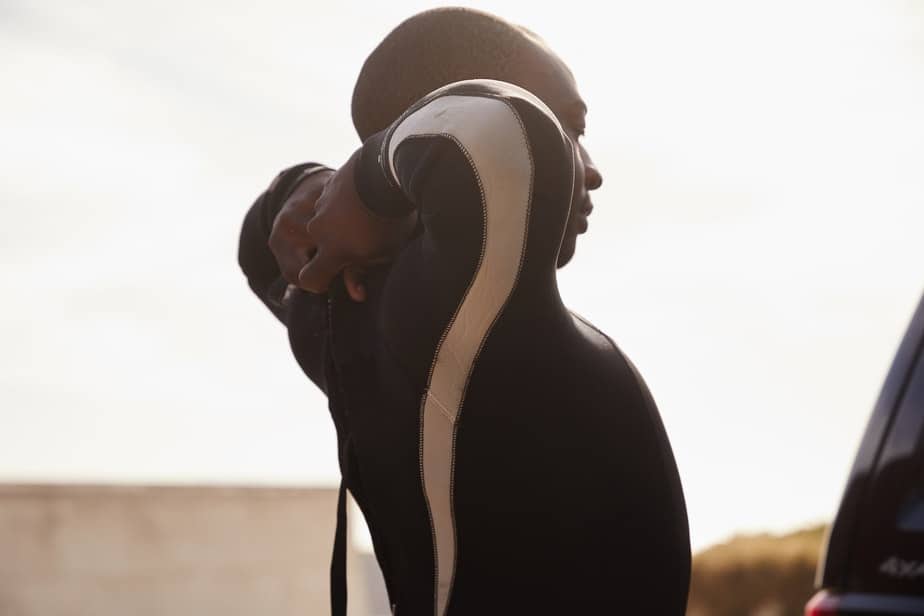The first time you don your wetsuit, it may feel a little too stiff for your liking. You may feel that your movements are restricted and you struggle to perform the same motions you used to do. This is because new wetsuits conform to a standard fit; they are not going to fit you like a bespoke suit will. However, the more you wear it, the more it will start to get broken in and conform to your body shape better.
To break in a wetsuit refers to loosening up the wetsuit enough so that it allows you to move with little to no restrictions while still having a snug fit on your body. Many people disagree on whether a “break-in” process is even necessary. Wetsuits don’t work like jeans; the argument is that a wetsuit that has been broken in is thin and loose which decreases its insulating capabilities. In this article, we’ll discuss ways that you can get that “broken in” feeling in a wetsuit so that you can stay warm and move without restrictions.
How to loosen up a tight wetsuit
Wetsuits nowadays have a very short break-in period because the neoprene material it is constructed from is already quite stretchy. The first time you wear your wetsuit, it should already be a decent balance of being tight, but not so tight that you struggle to breathe or move around in it. If the wetsuit fits you well enough, then you can count on it to adapt to your body shape over time.
There isn’t much of a trick to breaking in a wetsuit. You just need to wear it often and move around in it a lot. Just putting on the wetsuit will stretch it out just a bit each time. The areas that will get stretched the most from donning the wetsuit will be the shoulder region of the suit. The legs get stretched to a lesser degree when you reach down to pull it up through your legs..
Once you’re in the wetsuit, you can do some light stretches or movements. Consider doing some lunges, squats, arm swings, and the like. In short, you are basically doing a standard warm up routine. It’s not a bad idea because you’re about to do some physical activity anyways, but you can also break-in your wetsuit at the same time.
To speed up the breaking in process, you can even wear the wetsuit out of the water for as long as you can bear the heat/cold. This is the only acceptable way to speed up the wetsuit breaking in process.
If you think that you can break-in the wetsuit faster by pulling or stretching it when you’re not even wearing the wetsuit, you run the risk of tearing the neoprene or unevenly stretching it out. In short, it’s not a good idea to stretch your wetsuit other than to wear it and use it normally.
Wearing your new wetsuit for the first time
So you finally have your own wetsuit. Maybe you were tired of using rental wetsuits or maybe you just wanted one of your own. Here’s how you can make it truly yours.
After you’ve donned your wetsuit, first pull on the neck opening a bit to open up some space for air to vent from the suit. Next, position your upper legs at a 90 degree angle to your torso; it should look like you are sitting in a chair. Move your knees apart and together kind of like you’re flapping them. This vents the air trapped in the crotch area.
If no air is able to enter your suit, it is an indication that your wetsuit may be too tight. If little to no air is entering, then neither is much water. Wetsuits aren’t designed to keep you dry, but they are supposed to keep you warm. You also want water circulating in your crotch area for when you pee in your wetsuit. You can also consider that part of the christening process if you’d like.
Keep in mind that the thicker a wetsuit is, the more restrictive it will feel. You may never be able to reach full range of motion if your wetsuit is too thick. With that said, most of the time, a standard 3mm wetsuit is more than adequate for most scenarios, and that is thin enough for you to break-in quickly.
How tight should a wetsuit fit?

With other watersports clothing, you have the option of wearing them tight or loose such as a rashguard, but with wetsuits the only option is tight. Wetsuits are designed to insulate your body heat, and it can only do that if it’s close to your skin. The wetsuit must trap the heat your body produces while keeping the thin layer of warm water in your suit from leaking out too quickly.
If your wetsuit is too loose, the cold water will circulate the suit too quickly and take heat away from your body, defeating the point of even wearing a wetsuit in the first place. On the other hand, a wetsuit cannot be too tight otherwise you won’t even be able to move properly in it. You should still be able to easily breath and move freely, but there may be an adjustment period.
A wetsuit should feel like a second skin. It may not feel like that at first until you break it in. When wearing your wetsuit, it should not have any wrinkles, creases, or folds. If the wetsuit is a full suit, its arms should reach the wrists, and legs should reach the ankles, and a portion of your neck will also be covered.
Don’t be alarmed if some water enters your wetsuit; that is perfectly normal. However, it’s not normal if water can freely enter and exit the suit. That is a sign that the wetsuit is perhaps a bit too loose. It’s easy to tell when a wetsuit is loose, but the tricky part is determining how tight a wetsuit should fit without being too tight.
Here are some factors to consider when shopping for a wetsuit:
- If your neck is getting squeezed and it’s hard to breathe, it’s too tight.
- If normal blood flow is being restricted, it’s definitely too tight.
- If the wetsuit doesn’t conform to the shape of your body (i.e. there are lots of creases and empty space), it’s not a good fit or too loose.
- If certain parts of the wetsuits are stretched heavily (e.g. you have broad shoulders or a large chest, etc.), then the wetsuit is not a good shape for you or it’s too tight.
- If the wetsuit keeps chafing against you, consider wearing something under your wetsuit. Otherwise, it may be too tight.
- If you can’t wear a base layer, it’s too tight.
- Some people on purposely buy one size too small than the recommended size because they want a snug fit or intend to break it in. This may or may not work for you depending on your body shape.
How to find a well-fitted wetsuit
Maybe this whole “breaking in” process is something you want to avoid in the first place. Even a new wetsuit that is the optimal size will feel somewhat stiff and tight at first. Is there a wetsuit that fits just right off the rack?
For the highest chance of a wetsuit fitting you comfortably immediately, you’ll want to look for a wetsuit that offers more stretch. Look for wetsuits made of higher-grade materials, such as the super stretch neoprene that is 300% stretchable than regular neoprene. This material won’t necessarily get “broken in”, however it will give you that snug and comfortable feeling right away.
If a wetsuit is too small, don’t try to stretch it so it fits you. It probably never will and you run the risk of tearing the neoprene. A small wetsuit will cause chafing in the armpit and neck areas. Furthermore, it will fatigue you quickly since you’ll be forcing your muscles to fight against the tightness of the wetsuit. You may also experience poor circulation which can make it difficult for you to stay warm in the water.

Wetsuits that are too large will not keep you warm because the water will be able to flush out whatever warmth is trapped in your suit. It will also provide limited improvements when it comes to buoyancy. A large wetsuit will also cause you to fatigue more quickly because of the extra drag that comes with wearing it.
If it’s possible, you should try on a wetsuit before buying it. It’s possible to buy online if you already have wetsuit experience to draw from, and measurements to compare with. However, even if a wetsuit fits, that doesn’t mean it’s comfortable. And even if a wetsuit isn’t comfortable right away, there’s a possibility that you just need to break it in.
Ultimately, it is up to you to decide if a wetsuit is acceptably comfortable off the rack or if you are willing to break it in. If the wetsuit is comfortable because it is too tight or doesn’t fit your body shape, then don’t even try to break it in and just try on a different wetsuit.
What’s the difference between a new wetsuit and a broken-in one?
A brand new wetsuit will be thicker, tighter, and warmer compared to an older one. Breaking it in is especially important for activities like surfing and swimming where the extra flexibility makes a big difference.
When you enter the water with a new wetsuit, you’ll find that you’re more buoyant by 1-2 pounds compared to an older wetsuit of the same thickness. The reason for this is that the older wetsuit has been worn down and is literally thinner now, making it less buoyant as well.
Broken-in wetsuits will give you more freedom of movement because the material is not only stretched out, but thinner as we mentioned. This can be a double-edged sword: if the wetsuit has become too loose or thin, then more water will come in and flush out the warm water inside. The thin neoprene will also not be as effective at insulating heat. In other words, the broken-in wetsuit will not be as warm.
If you’re interested in buying some wetsuit products, consider checking out our review of the following:

